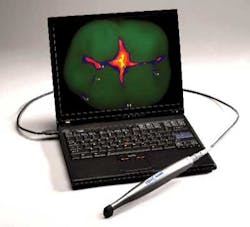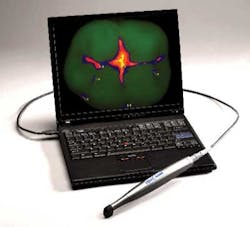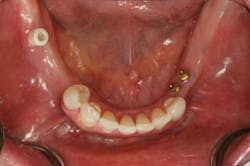Don't drill your patients … thrill your patients
Jeff T. Blank, DMD
For more on this topic, go to www.dentaleconomics.com and search using the following key words: Air Techniques, Spectra, caries detection, decay, enamel, Jeff T. Blank, DMD.
Over the past year, I began working with Air Techniques, a company known mostly for the production of digital and traditional X-ray equipment, air compressors, and state-of-the-art "waterless" suction units. Roughly a year ago, Air Techniques launched Spectra, an entirely novel concept in caries detection. I can honestly say that this technology, hands down, has had the single greatest positive impact on my practice in 2011.Greater than 90% of new, incipient decay is found in the pit and fissures of posterior teeth. For years researchers consistently demonstrated that visual-tactile (visual exam plus dental explorer) is accurate 24% of the time. The combination of the convoluted morphological folds, blunderbuss invaginations, and dense fluoride-rich nature of enamel today render the explorer inadequate and digital radiographs doubtful for diagnosis of the early carious lesion.
Alternative methods for diagnosing occlusal decay have been researched since the 1920s, and within the past decade various forms of fluorescence have been harnessed and have proven to increase the sensitivity (ability to detect a lesion) and specificity (ability to rule out a lesion) of early caries diagnosis. Examples of available devices include DIFOTI (Electro-Optical Sciences), DIAGNOdent (KaVo), Caries-ID (Midwest), and SOPROLIFE (Acteon North America). Each have much clinical merit and research to validate their effectiveness.
Spectra is an intraoral camera-based system that uses six LEDs to emit 405 nm wavelength UVA light and a CMOS sensor to record the fluorescence emissions of porphyrins, which are metabolites of cariogenic bacteria found at the various levels of the tooth during the decay process.
The most obvious advantage of Spectra is the Doppler radar image, created by the VISIX software included with the device, which can interface with most major practice management software systems (Fig. 1).
Rather than simply giving a numerical value or audible beep over a pinpoint area of the tooth, the entire tooth surface is mapped with color-coded areas that indicate not only the presence of decay, but also the estimated depth of the lesion. This caries "map" is an amazing patient communication tool, and as the title of this column suggests, it can discern those lesions that require surgical intervention (drilling) from those that do not.
In my practice, being able to identify what I call the "stinkers," or hidden caries that on the surface appear tiny but can turn into schedule wrecking near root canal disasters, is nothing short of a lifesaver. Man, how I hated explaining to patients why what we scheduled as a simple class I composite had become a root canal, core, and crown, or a similar variation (Fig. 2).
To sum up my experience with Spectra — it catches lesions much earlier (and with more confidence), which leads to more dentistry. It boosts my CAMBRA program, which leads to more testing and remineralization product sales. Spectra discerns which sealants can be delegated to auxiliaries verses those that are actually preventive resin restorations (PRR – CDT Code D1352), which generates more revenue.
It aids in time scheduling, need for anesthesia, and estimated cost of services, all of which reduce headaches for the entire dental team. I invite you to check out their website at www.airtechniques.com and click on Spectra Caries Detection Aid. This thing is beyond cool. It's real.
(Note: References are available from the author upon request)
Jeff T. Blank, DMD, graduated from the Medical University of South Carolina, College of Dental Medicine in 1989. He maintains a full-time private practice in Fort Mill, S.C., and is the chief instructor for New Millennium Education. Reach him at [email protected], or visit his website at www.carolinasmilecenter.com.
Past DE Issues


